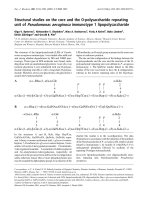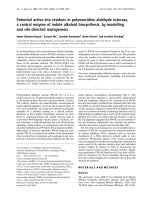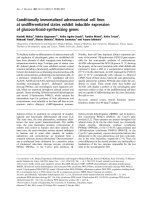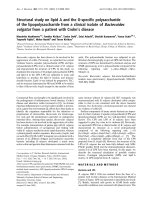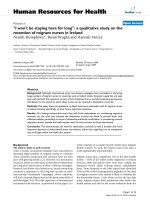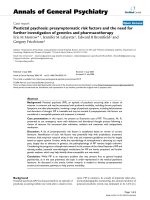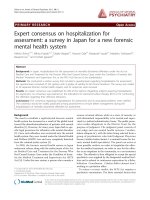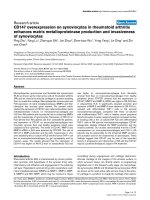Báo cáo y học: " “I’m on it 24/7 at the moment": A qualitative examination of multi-screen viewing behaviours among UK 10-11 year old" pptx
Bạn đang xem bản rút gọn của tài liệu. Xem và tải ngay bản đầy đủ của tài liệu tại đây (248.95 KB, 8 trang )
RESEARC H Open Access
“I’m on it 24/7 at the moment": A qualitative
examination of multi-screen viewing behaviours
among UK 10-11 year olds
Russell Jago
1*
, Simon J Sebire
1
, Trish Gorely
2
, Itziar Hoyos Cillero
3
and Stuart JH Biddle
2
Abstract
Background: Screen-viewing has been associated with increased body m ass, increased risk of metabolic syndrome
and lower psycholo gical well-being among children and adolescents. There is a shortage of information about the
nature of contemporary screen-viewing amongst children especially given the rapid advances in screen-viewing
equipment technology and their widespread availabi lity. Anecdotal evidence suggests that large numbers of
children embrace the multi-functionality of current devices to engage in multiple forms of screen-viewing at the
same time. In this paper we used qualitative methods to assess the nature and extent of multiple forms of screen-
viewing in UK children.
Methods: Focus groups were conducted with 10-11 year old children (n = 63) who were recruited from five
primary schools in Bristol, UK. Topics included the types of screen-viewing in which the participants engaged;
whether the participants ever engaged in more than one form of screen-viewing at any time and if so the nature
of this multiple viewing; reasons for engaging in multi-screen-viewing; the room within the house where multi-
screen-viewing took place and the reasons for selecting that room. All focus groups were transcribed verbatim,
anonymised and thematically analysed.
Results: Multi-screen viewing was a common behaviour. Although multi-screen viewing often involved watching
TV, TV viewing was often the background behaviour with attention focussed towards a laptop, handheld device or
smart-phone. There were three main reasons for engaging in multi-screen viewing: 1) tempering impatience that
was associated with a programme loading; 2) multi-screen facilitated filtering out unwanted content such as
advertisements; and 3) multi-screen viewing was perceived to be enjoyable. Multi-screen viewing occurred either in
the child’s bedroom or in the main living area of the home. There was considerable variability in the level and
timing of viewing and this appeared to be a function of whether the participants attended after-school clubs.
Conclusions: UK children regularly engage in two or more forms of screen-viewing at the same time. There are
currently no means of assessing multi-screen viewing nor any interventions that specifically focus on reducing
multi-screen viewing. To reduce children’s overall screen-viewing we need to understand and then develop
approaches to reduce multi-screen viewing among childr en.
Background
Screen-viewing time (TV viewing, computer game time
and internet use) has been associated with higher levels
of adult obesity, type 2 diabetes and all cause mortality
[1,2]. Scre en-viewing has also been associated with
increased body mass, increased risk of metabolic
syndrome and lower psychologica l well-being among
children and adolescents [3-6]. Youth screen-viewing is
a relatively stable behaviour which tracks moderately
from youth to adulthood [7], and h igh l evels of youth
TV viewing have been a ssociated with increased risk of
adult obesity [8]. Among adults participating in the US
National Health and Nutrition Examination Survey, long
periods of sitting time have been associated with adverse
health outcomes while breaks in sitting time h ave been
associated with lower waist circumference and C-
* Correspondence:
1
Centre for Exercise, Nutrition & Health Sciences, School for Policy Studies,
University of Bristol, 8 Priory Rd, Bristol, BS8 1TZ, UK
Full list of author information is available at the end of the article
Jago et al. International Journal of Behavioral Nutrition and Physical Activity 2011, 8:85
/>© 2011 Jago et al; licensee BioMed Central Ltd. This is an O pen Access arti cle distributed under the te rms of the Creative Commons
Attribution License (http://creativecommons.o rg/licenses/by/2.0), which permits unrestricted use, distribution, and reproduction in
any medium, provided the original work is properly cited.
reactive protein levels [9]. While there is currently a
shortage of comparable data for youth it seems plausible
that as well as screen-viewing overall sitting time may
also be associated with adverse health outcomes among
youth. Many national organisations have reco gnised the
potential problems associated with high levels of youth
screen-viewing and have implemented guidelines and
health promotion campaigns that include a focus on
strategies to reduce youth screen-viewing [10,11].
In order to develop effective interventions to change
youth screen-viewing it is necessary to better understand
the b ehaviour and the factors that influence whether a
child is a high or low screen-viewer [12,13]. Tradition-
ally, TV viewing has been the dominant form of youth
screen-viewin g and there is an e xtensive body of
research that has reported on patterns of youth TV
viewing [14,15], compliance with TV viewing recom-
mendations [16,17] and associations between TV view-
ing and obesity [3]. In recen t years the field has evolved
with additional assessments of computer and console/
video game time and other sedentary behaviours being
included in childhood studies [18,19]. There is, however,
a shortage of information about the nature of contem-
porary screen-viewing amongst children espec ially given
the rapid advances in screen-viewing equipment tech-
nology and their widespread availability. For example,
TV programmes are watche d on computers, games con-
soles can be used to surf the internet, Smartphones,
tablet computers and hand-held games play music,
video games and provide internet access, and laptop
computers can do all of the above. Anecdotal evidence
suggests that large numbers of children embrace the
multi-functionality of cu rrent devices to engag e in mul-
tiple forms of screen-viewing at the same time but we
are not aware of any study that has examined this iss ue.
As such, we do not know whether multi-screen viewing
takes place, if multi-screen viewing is associated with
adverse health outcomes or if interventions that target
multi-screen viewing should be developed. In addition,
children’s media multi-tasking may have implications for
the measurement of screen -viewing and sede ntary time.
For example, if a child is asked to self-report the time
they spend using different screen-viewing devices as
individual questionnaire items this may lead to an over
estimation of sc reen-viewing time i f they are using mul-
tiple screens concurrently.
The aim of the current paper was to address current
research limitations by conducting an explorat ory, quali-
tative study in which we examined whether UK children
report engaging in multiple forms of screen-viewing. We
also specifically sought to examine where multiple forms
of sc reen viewing occur, the nature of the viewing and
the reasons for engaging in the behaviour.
Methods
Recruitment and Participants
Focus groups were conducted with 10-11 year old chil-
dren who were recruited from five p rimary schools in
Bristol, UK. To represent the spectrum of local economic
diversitywerecruitedaprimary school from each quin-
tile of the Government’s school deprivation indicator for
Bristol schools [20]. All Year 6 (N = 261) students
attended a brief presentation in which they were invited
to take part in a research project. At the end of the pre-
sentation a member of the study team answered ques-
tions and provided information packs. The study w as
approved by a University of Bristol Ethics Committee.
Written parental consent was obtained for 63 children
(24% response rate). Ten focus group part icipant lists
were generated by randomly selecting 3 boys and 3 girls
as members of each group. Following participant drop
out, 55 children (30 girls, 25 boys) participated in the
focus groups, ranging in size from 4 to 6 pupils.
Focus Groups
The focu s groups were conducted in sch ool classrooms
and were recorded using a digital recorder (Olympus
DS-3400). One team member facilitated the focus
groups (SJS) while another took notes during the group
(IHC). The focus group was based on a semi-structured
topic guide. Topics included the types of screen-viewing
in which the partic ipants engaged; whether the partici-
pants ever engaged in more than one form of screen-
viewi ng at any time and if so the nature of this multiple
viewing; reasons for engaging in multi-screen-viewing;
the room within the house where multi-screen-viewing
took place and the reasons for selecting that room. The
semi-structu red format allowed for the discussion of
new topics raised by participants and for nuances to be
pursued. Focus groups were on average 44 minutes in
duration (range = 25 to 60 minutes).
Data analysis
All focus groups were transcribed verbatim and anon-
ymise d. As this project represented exploratory research
and we had no pre-conceived ideas about the likely
responses, we adopted a thematic analytical approach
[21]. Firstly, the transcripts were read line by line by
two team members (SJS and RJ) who marked the text
with initial codes that described the content of the
response [22]. Coding and theme generation was itera-
tive and refined throughout analysis. Codes were
entered as tree nodes in NVivo (Version 8, QSR, South-
port,UK).Hierarchiesofcodes were created and sum-
marised and themes within each group were developed
and reviewed by all of the authors and interpretations
were discussed and amended as necessary.
Jago et al. International Journal of Behavioral Nutrition and Physical Activity 2011, 8:85
/>Page 2 of 8
Results
The ana lysis yielded two overall themes. T he first theme
was S creen-viewing types and access to equipment and
explores children’s current screen-viewing behaviours. The
second theme was Multi-screen-viewing;andconsistedof3
sub-themes exploring the type and nature of multi-screen
viewing, reasons for multi screen viewing and the locations
and times of day that these behaviours take place. Themes
and sub-themes are presented in detail below.
1) Screen-viewing types and access to equipment
In order to initiate a discuss ion about screen-viewing
the focus group started by asking participants to identify
the types of sc reen-viewing equipment that they had
access to in their homes. Almost all of the children
(96%) reported having access to a TV, 76% had access
to a handheld console such as a Nintendo DS, DSi or a
Sony PSP, 75% had access to a games console, 71% a
laptop, 62% a P C and 51% an interactive mobile phone.
The participants reported that on average they had five
different screen-viewing devices within their home
(range 3-8). The responses to this question therefore
indicated that the participants had a number of oppor-
tunities to engage in multi-screen viewing.
In terms of activities, it was clear that TV viewing was
very common with viewing including both the watching
of TV programmes at their scheduled time and watch-
ing TV “ on-demand” via the internet or recorded
favourite programmes. For example:
“ Because you can get like iPlayer and just watch it
live” (Female)
“I went camping with my friends on the day when it
was the [reality show] final so I just went on ‘TV on
Demand’ and I went on ‘ catch up’ be cause they do n’ t
have the break. It’s the same but they don’t have the
break, the adverts“ (Male) “
If I watch [TV p rogramme] and there’ ssomething
brand new on like that’s apparently r eally good and I
want to watch that but they’re on at the same time.
Sometimes I record like the one that’snewsoIcan
watch [TV programme] so I can catch up with what’ s
happening“ (Female)
The participants a lso reported extensive use of laptop
computers and generic computers. It appeared that both
devices were mainly used for social networking, online
gaming, chat and watching videos on YouTube.
“ I’ monmyDSiandmylaptop.OnmyDSiI’mon
MSN and on my laptop I’m on Facebook and then the
TV is on” (Female)
“I chat to my friends on the laptop quite a lot” (Male)
Participants also reported extensive used of handheld
gamesconsolessuchasNintendoDS,PSPandSmart-
phones which were mainly used as a medium to play
games.
“I play on the DS for hours on end” (Female)
“I play on my mum’s iPhone all the time just play on
the games that are on there” (Male)
“I use my mobile phone to like text people and then I
watch TV like before I go to bed” (Female)
2) Multi-screen-viewing
The participants reported that they engaged in multi-
screen viewing and further analysis indicated that this
overall theme could be divided into: a) the forms of
multi-screen viewing and the reasons for engaging in
the behaviour; b) where multi-screen viewing took place,
and the reasons for choosing that location; and c) when
multi-screen viewing took place. Each sub-theme is pre-
sented below.
a) Multi screen-viewing forms and reasons for engaging in
the behaviour
A number of children r eported watching TV and using
a laptop at the same time. For some children these dual
behaviours were engaged in because the child was bored
during TV commercials.
“I watch TV and then I get bored with all the adverts
so I get my laptop and start going on it and then when
the show comes back on it I watch it, and then when it’s
the adverts I play on my laptop“ (Female).
“So it’snicejustwhenyou’ re tired just to lounge back
and watch the TV and then when it’ sadvertsyoujust
watch something else like YouTube “ (Female)
For many children the TV was just used as a method
of filling time while they waited for a game to load on
the laptop:
“I wa s going to say if I am on the laptop, if like some-
thing is loading on the laptop I would watch TV while it
is loading“ (Male)
“When the computer is loading and a games takes
and it’s like 1%, 2% and it needs to get to 100% and it’s
loading for a long time then I just turn the TV on
because I’m quite impatient“ (Female)
Children reported occasions when the TV was on but
the programme was predominantly being watched by
another family member. In these instances, TV viewing
was a background behaviour with the majority of the
attention focussed towards the laptop:
“ So he [father] was watching t hat and I just didn’ t
want to watch it so I p icked up my laptop and started
going on my laptop, because I don’tlike[motoringpro-
gramme] so you do something else“ (Female)
Finally, the children also reported using a laptop while
watching TV as it enabled the children to do two things
at once.
“Ithinkit’sbecauseI’m really eager to do both things,
like when you’re watching TV, I like to go and watch TV
but I also really want to do something else on the com-
puter at the same time“ (Male)
Jago et al. International Journal of Behavioral Nutrition and Physical Activity 2011, 8:85
/>Page 3 of 8
“You might be watching like your favourite TV pro-
gramme and if you were playing on something at the
same time you might like say you were on a game and
it seems to you that it’s really important, like you’ve got
to complete the levels so you’ ve got to watch it at the
same time“ (Female)
It was also clear that multi-screen-viewing occurred
using a TV and a handheld c onsole because either the
child was not particularly interested i n the TV pro-
gramme that someone else was watching or the hand-
held was used to fill time during commercial breaks.
“S ometimes I DS while my parents are wat ching the
news or while my brother is watching something like [TV
programme] or something like that“ (Female)
“Yes on TV while I am waiting, while the adverts are
going I just sometimes get a DS out or something“ (Male)
“ Ican’ t be bothered to change the channel so I just
play on my DS” (Male)
Participants reported using mobile phones while either
watching TV or using a computer. In these instances
the phone use was either a function of responding to
incoming calls and texts while engaged in TV viewing
or a desire to engage in two behaviours at once.
“Sometimes I do two things because like when some-
body texts me and I text them back. It’s like when the
computer is loading again I just text somebody“ (Male)
“I sometimes like watch the TV and go on my laptop,
or like go on my phone and watch the TV.” (Female)
Similarly, handheld devices were often used as meth-
ods to fill time and address boredom when using a
laptop.
“Sometimes I go on my DS or somethi ng when a game
is loading or something on my laptop because I don’t
like waiting, I’m very impatient.” (Male)
Although the majority of the participants reported
that they engaged in multi-screen viewing, and overall
there were positive attitudes towards multi-screen view-
ing, there were a few female participants who did not
enjoy or engage in multi-screen viewing.
“It is easier to concentrate on one thing rather than,
like, two things. Because if I try and do two things at
once, I can’t concentrate on what I’m doing” (Female)
“We ll, I do n’ t really do two screen things. I wouldn’ t
use a DS or anything, I’d read” (Female).
b) Multi screen-viewing location and reasons for location
selection
The participants reported that multi-screen viewing
occurred either in their bedroom or in the main living
area of the home. The bedroom was the most frequently
reported location for multi-screen viewing and this loca-
tion was o ften selected because it was perceived as a
quiet space that afforded privacy from siblings and
adults.
“In my bedroom I do the TV, the laptop and the music
because that’s my own place and I just relax in there so
it’s usually there” (Male)
“MostlyIdoitinmybedroombecauseIlike,having
conversations with my friends and watching TV in pri-
vate” (Female)
“I normally go upstairs, it’ smorelikethere’ s loads of
people downstairs so it’s somewhere quieter in my bed-
room“ (Male)
The bedroom was also often used for multi-sc reen
viewing because it was the room where the screen view-
ing equipment was stored.
“I have a laptop in my bedroom and I have a TV in
my bedroom and a DS and iPod and everything“ (Male)
“In my room, because I’ve got a telly, a laptop and all
the games consoles in my room apart from the Wii,
which is downstairs“ (Female)
The main family area was the other frequently
reported location for multi-screen viewing with this
location selected because of the location of t he equip-
ment, the comfortable nature of the surroundings and
the opportunity to spend time with other family
members.
“Well at my mum’ sI’d mostly be downstairs on the
Xbox, but at my dad’sI’ m normally downstairs because
he’sgota32” flat screen telly on the wall so I just like
chill out and just watch TV” (Male)
“I go in the living room because it is like really relax-
ing you have got like the windows open, the sun is co m-
ing in and it is just nice and pleasant” (Male)
“I would normally do it down stairs because it is with
family“ (Female)
“And like in the living room it is nice to have a bit of
company sometimes“ (Female)
c) Timing of multi-screen viewing
The participants reported that multi-screen viewing
occurred across the day but the main periods were
after-school and at the weekend. It was, however,
noticeable that there was considerable variability in the
level and timing of viewing and this appeared to be a
function of whether the participants attended after-
school clubs with club or activity participation resulting
in lower levels of screen-viewing after school.
After school and evenings
Many child ren explained how their multi-screen viewing
would start once they arrived home from school.
“When I come home from school, your friends want to
tell you something but they don’twanttotellyouin
school so you go on Facebook and you talk to them”
(Female)
“ Normally about f our o’ clock after school because,
that’s when all the repeats are on after school as well so
Jago et al. International Journal of Behavioral Nutrition and Physical Activity 2011, 8:85
/>Page 4 of 8
I normally go on the laptop or on the phone or some-
thing like that” (Female)
“ When I go home from school I sit on the sofa and
watch TV for like an hour and a half or something, then
I go up to play on my PlayStation 2. Then my brother
comes in and annoys me and says, ‘ I want to play with
you,’ and then I have to, go and get my DS so then we
link up or play with the DS. Then, like after half an
hour of that, um, I go back on my PlayStation an d then,
um, send a few text messages on my phone to my
friends” (Male)
A number of participant s indicated that their screen-
viewing would persist through the evening until they
went to bed.
“ SometimesIdowatchitallthewaytobedtime”
(Male)
“I have tea and t hen me and my family just sit down
and watch TV I take my PSP u p to bed and just play
on that until like twelve o’clock” (Male)
Some children identifi ed that going to after school
activities or clubs prevented them from screen-viewing
in the home.
“Idon’t do it on the weekends or Thursday because on
Thursday I’ve got my piano lessons and on the weekend I
just like to get out at weekends because it’s free days, you
don’t have to go to school” (Female)
“On school days I usually hav e a club so when I get
home I’m usually just I don’t get much time to watch
TV. So on weekends I get more time” (Male)
“ I only do it on weekends usually after school, I do
quite a lot of stuff like I do football and then I do like
I go swimming and stuff like that and go around my
friend’s house”
Weekends
Some participants reported greater screen-viewing at
weekends and this was perceived to be a function of the
increased time available.
“At the weekends I watch more telly because there’ s
more time to fill. When you’ re at school you’ re only
home before it’s another four hours before you anot her
six hours before you go to bed at weekends usually peo-
ple are busy so there’s more time to watch telly because
you don’t have other things to do” (Male)
“ On the weekends when I first get up I p lay on my
DS and then erm aft er breakfast I go on the computer
till lunch. Then I go back on, then when tea comes I
goeatitandthenIplayonmyDStillIgotosleep“
(Female)
In contrast, other participants’ weekends were full of
activities outside of the home which they associated
with having less time for screen-viewing:
“So at weekends I’ve got loads of things on so I don’ t
watch TV, like almost not at all”. (Male)
“Well on Saturday, I do a club so in the morning me
and my s ister wouldn’ t go on anything until about three
o’ clock because the clubs are so long, so at three o’clo ck
I’d probably then go on the laptop or maybe go out w ith
my friends” (Female)
Mornings
Some participants also reported engaging in multi-
screen viewing before school but this appeared to be a
less prevalent behaviour.
“In the morning I play on my DS till my mum gives me
breakfast and after I get dressed if I have got time”
(Female)
“Lik e, when I’m, like, in bed, just wake up, turn on the
TV, and go on the laptop” (Female)
Discussion
Consistent with previous studies the data presented here
suggest that contemporary UK children are engaged in
high a mounts of screen-viewing [6,23]. Although t here
was considerable variability in viewing patterns, screen-
viewing appears to be an embedded behaviour with
many children regularly engaging in two or more forms
of screen viewing at the same time. It is important to
highlight that a lthough the majority of the multi-screen
viewing involved TV viewing, this rarely appeared to be
the dominant activity. This finding might be a function
of the passive nature of TV as it is possible to do
another activity while watching TV. It is, for example,
more difficult to do something else whilst playing a high
action, fast response video game. The data reported
here, therefore, suggest that new strategies that focus on
reducing multi-screen viewing are required.
Participants reported that there were three main rea-
sons for engaging in multi-screen viewing. Firstly, it
tempered impatience that was associated with a pro-
gramme loading or waiting for a response to a text mes-
sage or instant message. For these children the second
or t hird screen filled the time and prevented b oredom.
Secondly, multi-screen viewing was a reactive response
that enabled t he child to use t heir time more efficiently
as they could filter out unwanted content such as adver-
tisements and focus their attention on just the content
that interested them. Thirdly, multi-screen viewing was
a proactive decision with the children opting to do two
or more things at once as it was perceived to be more
interesting or more enjoyable. It is not clear the extent
to which the proactive viewing was influenced by high
levels of access to multiple pieces of screen-viewing
equipment or a more general preference. Either way, as
the ch ildren repor ted having access to an average of five
pieces of screen-viewing equipment in their home it is
relatively easy for the majority of children to engage in
multi-screen viewing. Collectively, these findings suggest
Jago et al. International Journal of Behavioral Nutrition and Physical Activity 2011, 8:85
/>Page 5 of 8
that in order to reduce screen-viewing we need to b e
able to improve our understanding of why children
engage in multi-screen viewing. The increased under-
standing could then be used to inform the development
of intervention approaches that are targeted towards the
underlying factors that influence an individual child’ s
viewing behaviours.
Implications for strategies to reduce youth screen-
viewing
Screen-viewing, and multi-screen viewing in particular,
occurred either within the main family room or within
the child’ s bedroom. Moreover, a considerable pro por-
tion of the screen-viewing occurs on portable devices
that can easily be moved from one room to another
within the house. Previous studies have indicated that
the presence of a TV in a child’ sbedroomhasbeen
associated with higher screen-viewing [24]. Conse-
quently a number of intervention approaches have
focussed on removing TV’s and media equipment from
children’ s bedrooms as part of broader screen-viewing
reduction strategies [25]. The portable nature of current
devices suggests that such approaches may not be
appropriate for contemporary viewing patterns . Alterna-
tive approaches that focus on limiting screen-viewing
time, regardless of location, may be more relevant for
contemporary viewing patterns. These new approaches
could also be mapped onto goal setting and goal moni-
toring interventions in which the children take owner-
ship of their own viewing behaviours.
Participants reported extensive use of on-demand TV-
viewing facilities. It is not clear if the use o f on-demand
services resulted in a higher volume of viewing as the
children could always find something of interest to
watch, or if the on-demand services enabled the partici-
pant to only watch programmes of particular interest
without an increase in volume. A n umber of interven-
tions that have focussed on reducing screen-viewing
have included goal setting components in which the
participants have been encouraged to identify the pro-
grammes that they want to watch and then limit their
viewing to those programmes [25,26]. On-demand ser-
vices could therefore be a useful tool that facilitates TV
viewing goal setting and monitoring. As such, further
research that specifically focuses on: a) whether on-
demand viewing results in higher overall viewing levels;
and b) whether use of on-demand services can be used
as a goal-setting tool to reduce overall screen-viewing
time, is warranted.
The after- school period appears to be a critical period
for screen-viewing. After-school screen-viewing appears
to be influenced by whether the child engaged in orga-
nized after-school activities with club participat ion asso-
ciated with lower screen-viewing. Although the data
presented here are not objective, the patterns reported
are consistent with after-school physical activity litera-
ture. A number of studies have suggested that the per-
iod between the end of the school day and the evening
meal is when discretionary physical activity occurs
[27,28]. The after-school period is also when the highest
proportion of moderate-to-vigorous physical activity is
obtained [29]. As such the after-school period has been
identified as a critical window for the promotion of phy-
sical activity and a number of interventions have
focussed on increasing physical activity at this time
[28,30]. The data presented here suggest that the after-
school period may also be a key time period in which to
limit screen-viewing and strategies that focus on redu-
cing screen-viewing during this window are needed.
Measurement
Measuring s edentary behaviours for purposes of both
research and population surve illance is c hallenging. Our
findings raise some important issues for assessment. Given
the clear indication that children both switch between
screen tasks on a frequent basis, and that multi-tasking on
screens also occurs, the way we assess such behaviours
needs a closer look. There are two main outputs from
assessing sedentary behaviours. These are total sedentary
time, best assessed using objective methods such as accel-
erometers or posture monitors, and time spent in key
sedentary behaviours, such as screen time. Self-report
measures will be used for this. Assessing individual seden-
tary behaviours is necessary if we are to better understand
the be havioural patterning of certain sedentary tasks and
for the development of behaviour change interventions.
Using objective methods for assessing total sedentary
time will be unaffected by the discovery that many young
people are likely to be multi-tasking on screens. However,
these behavioural patterns do have important implications
for assessing individual behavi ours by self-report . For
example, it is possible that children switching between TV
viewing and laptop use, or operating them more o r less
simultaneously, may over-report time in both when
responding to certain questions. Self-report questions may
need to address this by allowing the reporting of multi-
tasking o r for stating the main task being undertaken.
Assessment of sedentary behaviour will also be affected by
the development of new technologies that allows for ‘con-
vergence’ of platforms. For example, children already
watch TV programmes or films on their laptops, and listen
to music played f rom Smartphones. The implications of
such changes for measurement are yet to be explored but
it is an issue for consideration.
Strengths and limitations
This is the first study to assess the extent to which
children engage in multi-screen viewing and as such
Jago et al. International Journal of Behavioral Nutrition and Physical Activity 2011, 8:85
/>Page 6 of 8
the paper advances our understanding of youth screen-
viewing behaviours. We recognise that quantitative
data from a larger number of participants would be
needed to ascertain the extent o f youth engagement in
multi-screen viewing. However, the information
included in this paper is an essential first phase of
research and could be used to in form the development
of more extensive assessment. Although we recruited
schools to provide participants from a range of socio-
economic backgrounds the sample is not sufficiently
large to allow for a for mal analysis of differences by
socio-economic group. The major limitation of the
work is the relatively small sample of participants that
were recruited from five schools in a single city which
limits our ability to general ise findings to other cities
and countries.
However, it was clear that saturation, where no new
information was obtained from subseque nt student
focus groups, was achieved. We are therefore confident
that the data presented here are an accurate representa-
tion of the views of children in the local area.
Conclusions
The data from this qualitative study indicate that con-
temporary U K children regularly engage in two or more
forms of screen-viewing at the same tim e. As such there
is a need to assess multi-screen viewing and associations
between multi-screen viewing and health outcomes.
However, there are currently no means of assessing
multi-screen viewing and therefore techniques that
assess multi-screen viewing are urgently needed. Equally,
there are currently no interventions that specifically
focus on reducing multi-screen viewing. A greater
understanding of why multi-screen viewing occurs, how
on-demand services are used, and how multi-screen
viewing could be reduced in the after-school period is
needed to design new, more effective interventions.
Multi-screen viewing is a new form of screen-viewing
and in o rder to reduce children’s overall screen-viewing
we need to understand and then develop approaches to
reduce multi-screen viewing.
Acknowledgements
This project was funded by a small research grant from the Faculty of Social
Sciences of Law at the University of Bristol. This report is also research
arising from a Career Development Fellowship (to Dr Jago) supported by
the National Institute for Health Research. The views expressed in this
publication are those of the authors and not necessarily those of the NHS,
the National Institute for Health Research or the Department of Health.
Author details
1
Centre for Exercise, Nutrition & Health Sciences, School for Policy Studies,
University of Bristol, 8 Priory Rd, Bristol, BS8 1TZ, UK.
2
School of Sport,
Exercise & Health Sciences, Loughborough University, UK.
3
Nursing
Department, University of the Basque Country, Spain.
Authors’ contributions
The project was conceived by RJ, SJS, TG and SJHB. All data were collected
by SJS and IH. Analysis was performed by SJS, RJ and IH. RJ led the drafting
of the manuscript with all authors adding sections for the paper. All authors
made critical contributions to the manuscript and approved the final
version.
Competing interests
The authors declare that they have no competing interests.
Received: 18 March 2011 Accepted: 3 August 2011
Published: 3 August 2011
References
1. Dunstan DW, Barr EL, Healy GN, Salmon J, Shaw JE, Balkau B, Magliano DJ,
Cameron AJ, Zimmet PZ, Owen N: Television viewing time and mortality:
the Australian Diabetes, Obesity and Lifestyle Study (AusDiab).
Circulation 2010, 121:384-391.
2. Hu FB, Li TY, Colditz GA, Willett WC, Manson JE: Television watching and
other sedentary behaviors in relation to risk of obesity and type 2
diabetes mellitus in women. Jama 2003, 289:1785-1791.
3. Marshall S, Biddle SJH, Gorley T, Camerron N, Murdey I: Relationships
between media use, body fatness and physical activity in children and
youth: a meta-analysis. Int J Obes 2004, 28:1238-1246.
4. Jago R, Baranowski T, Baranowski JC, Thompson D, Greaves KA: BMI from
3-6 y of age is predicted by TV viewing and physical activity, not diet.
Int J Obes Relat Metab Disord 2005, 29:557-564.
5. Ekelund U, Brage S, Froberg K, Harro M, Anderssen SA, Sardinha LB,
Riddoch C, Andersen LB: TV viewing and physical activity are
independently associated with metabolic risk in children: the European
Youth Heart Study. PLoS Med 2006, 3:e488.
6. Page AS, Cooper AR, Griew P, Jago R: Children’s Screen Viewing is Related
to Psychological Difficulties Irrespective of Physical Activity. Pediatrics
2010, 126:e1011-1017.
7. Biddle SJ, Pearson N, Ross GM, Braithwaite R: Tracking of sedentary
behaviours of young people: A systematic review. Prev Med 2010,
51:345-351.
8. Viner RM, Cole TJ: Television viewing in early childhood predicts adult
body mass index. J Pediatr 2005, 147:429-435.
9. Healy GN, Matthews CE, Dunstan DW, Winkler EA, Owen N: Sedentary time
and cardio-metabolic biomarkers in US adults: NHANES 2003-06. Eur
Heart J 2011, 32:590-597.
10. Tremblay MS, Leblanc AG, Janssen I, Kho ME, Hicks A, Murumets K,
Colley RC, Duggan M: Canadian sedentary behaviour guidelines for
children and youth. Appl Physiol Nutr Metab 2011, 36:59-64.
11. Department of Health: Change 4 Life. 2009 [ />change4life/Pages/Default.aspx;].
12. Craig P, Dieppe P, Macintyre S, Michie S, Nazareth I, Petticrew M:
Developing and evaluating complex interventions: the new Medical
Research Council guidance. Bmj 2008, 337:a1655.
13. Baranowski T, Jago R: Understanding mechanisms of change in children’s
physical activity programs. Exerc Sport Sci Rev 2005, 33:163-168.
14. Taras HL, Sallis J, Patterson TL, Nader PR, Nelson JA: Television’s influence
on children’
s diet and physical activity. Journal
of Development and
Behavioral Pediatrics 1989, 10:176-180.
15. Durant RH, Thompson WO, Johnson M, Baranowski T: The relationship
among television watching, physical activity, and body composition of
5- or 6-year old children. Ped Exerc Sci 1996, 8:15-26.
16. Anderson SE, Economos CD, Must A: Active play and screen time in US
children aged 4 to 11 years in relation to sociodemographic and weight
status characteristics: a nationally representative cross-sectional analysis.
BMC Public Health 2008, 8:366.
17. Jago R, Page A, Froberg K, Sardinha LB, Klasson-Heggebo L, Andersen LB:
Screen-viewing and the home TV environment: The European Youth
Heart Study. Prev Med 2008, 47:525-529.
18. te Velde SJ, De Bourdeaudhuij I, Thorsdottir I, Rasmussen M, Hagstromer M,
Klepp KI, Brug J: Patterns in sedentary and exercise behaviors and
associations with overweight in 9-14-year-old boys and girls–a cross-
sectional study. BMC Public Health 2007, 7:16.
Jago et al. International Journal of Behavioral Nutrition and Physical Activity 2011, 8:85
/>Page 7 of 8
19. Gorely T, Biddle SJ, Marshall SJ, Cameron N: The prevalence of leisure time
sedentary behaviour and physical activity in adolescent boys: An
ecological momentary assessment approach. Int J Pediatr Obes 2009, 1-10.
20. School funding deprivation indicator. [ />schools/adminandfinance/financialmanagement/schoolsrevenuefunding/
archive/a0014385/school-funding-deprivation-indicator].
21. Braun V, Clarke V: Using thematic analysis in psychology. Qualitative
Research in Psychology 2006, 3:77-101.
22. Thompson JL, Jago R, Brockman R, Cartwright K, Page AS, Fox KR:
Physically active families - de-bunking the myth? A qualitative study of
family participation in physical activity. Child Care Health Dev 2009,
36:265-274.
23. Biddle SJ, Gorely T, Marshall SJ, Cameron N: The prevalence of sedentary
behavior and physical activity in leisure time: A study of Scottish
adolescents using ecological momentary assessment. Prev Med 2009,
48:151-155.
24. Gorely T, Marshall SJ, Biddle SJ: Couch kids: correlates of television
viewing among youth. Int J Behav Med 2004, 11:152-163.
25. Escobar-Chaves SL, Markham CM, Addy RC, Greisinger A, Murray NG,
Brehm B: The Fun Families Study: intervention to reduce children’sTV
viewing. Obesity (Silver Spring) 2010, 18(Suppl 1):S99-101.
26. Robinson TN: Reducing children’s television viewing to prevent obesity -
A randomized controlled trial. JAMA 1999, 282:1561-1567.
27. Brockman R, Jago R, Fox KR: The contribution of active play to the
physical activity of primary school children. Prev Med 2010, 51:144-147.
28. Atkin AJ, Gorely T, Biddle SJ, Cavill N, Foster C: Interventions to Promote
Physical Activity in Young People Conducted in the Hours Immediately
After School: A Systematic Review. Int J Behav Med 2010.
29. Nyberg GA, Nordenfelt AM, Ekelund U, Marcus C: Physical Activity Patterns
Measured by Accelerometry in 6- to 10-yr-Old Children. Med Sci Sports
Exerc 2009.
30. Jago R, Baranowski T: Non-curricular approaches for increasing physical
activity in youth: a review. Prev Med 2004, 39:157-163.
doi:10.1186/1479-5868-8-85
Cite this article as: Jago et al.: “I’m on it 24/7 at the moment": A
qualitative examination of multi-screen viewing behaviours among UK
10-11 year olds. International Journal of Behavioral Nutrition and Physical
Activity 2011 8:85.
Submit your next manuscript to BioMed Central
and take full advantage of:
• Convenient online submission
• Thorough peer review
• No space constraints or color figure charges
• Immediate publication on acceptance
• Inclusion in PubMed, CAS, Scopus and Google Scholar
• Research which is freely available for redistribution
Submit your manuscript at
www.biomedcentral.com/submit
Jago et al. International Journal of Behavioral Nutrition and Physical Activity 2011, 8:85
/>Page 8 of 8
